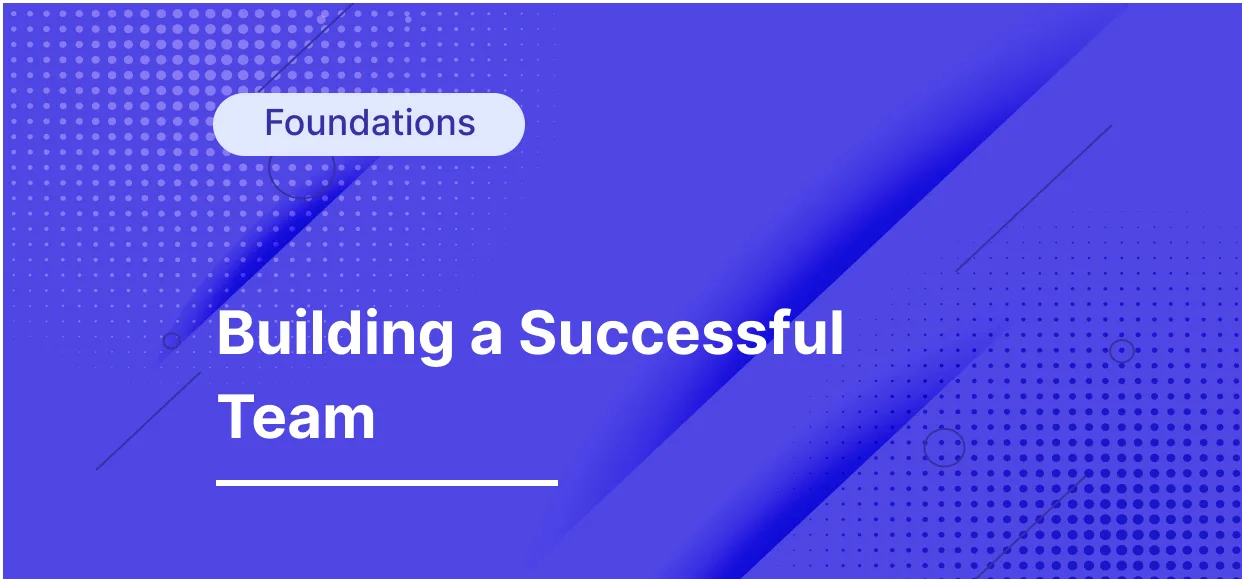- Experimentation,
- Personalization
How to Build a Team for Successful Personalization and Experimentation

In today's rapidly evolving digital landscape, personalization and experimentation have become crucial components of any successful marketing strategy. By tailoring content, messaging, and user experiences to the unique preferences and needs of individual customers, businesses can forge stronger connections with their audience and drive better results.
However, achieving true personalization requires more than just innovative tools and technology; it demands a strong, cohesive team that can work together to bring these tailored experiences to life.
In this playbook, we will discuss
👉 the vital role a well-rounded team plays in achieving personalization and experimentation goals,
👉 along with strategies for building the ideal team that can drive success in your organization.
Assemble the Right Team Members
A winning personalization and experimentation team consists of individuals with diverse skill sets, who collaborate effectively to create tailored experiences for customers. Let's dive into the roles and responsibilities of each team member, and understand how they contribute to the success of the personalization process:
Executive Leader: The Executive Leader is responsible for defining the overall vision and strategy for personalization and experimentation within the organization. They ensure alignment with business goals, provide necessary resources, and create a culture that fosters innovation and data-driven decision-making. They also serve as the primary advocate for personalization initiatives, helping to secure buy-in from stakeholders across the company.
Growth Marketer / CRO Manager: The Growth Marketer or Conversion Rate Optimization (CRO) Manager focuses on driving growth and improving conversion rates through personalized marketing campaigns and experiments. They identify opportunities for optimization, develop hypotheses, and design tests to validate these ideas. They also work closely with other team members to implement and analyze the results of these experiments, using data to inform future strategies.
Data Analyst: Data Analysts play a crucial role in the personalization process by collecting, analyzing, and interpreting customer data. They help the team understand customer behavior, preferences, and trends, providing valuable insights that inform content creation, user experience design, and development efforts. They also assist in setting up tracking and measurement systems, ensuring the team can monitor the performance of personalization and experimentation initiatives.
Content Creator: Content Creators are responsible for developing engaging, personalized content that resonates with the target audience. They collaborate with data analysts and UX/UI designers to understand customer preferences and create tailored messaging, visuals, and experiences. Their role also involves staying up-to-date with industry trends and best practices, ensuring the content remains fresh and relevant.
UX/UI Designer: The UX/UI Designer focuses on creating user experiences and interfaces that are both visually appealing and optimized for personalization. They use data-driven insights to inform design decisions, ensuring that the user journey is tailored to individual customer needs and preferences. They also collaborate with developers to implement their designs and ensure seamless functionality across various devices and platforms.
Developer: Developers play a critical role in bringing personalized experiences to life by building and maintaining the technical infrastructure required for personalization and experimentation. They work closely with UX/UI designers to implement responsive designs, develop custom features, and integrate third-party tools and technologies. They also ensure that the website or application is scalable, secure, and optimized for performance.
Project Manager: The Project Manager is responsible for overseeing the planning, execution, and monitoring of personalization and experimentation initiatives. They ensure that projects stay on track, within budget, and meet established goals and objectives. They also facilitate communication and collaboration among team members, helping to resolve any issues that may arise and maintain a focus on continuous improvement.
By assembling a team with these diverse skill sets and roles, organizations can build a strong foundation for successful personalization and experimentation efforts, ultimately driving growth and improving customer experiences.
It is essential to recognize that there is no one-size-fits-all solution when it comes to building a team for personalization and experimentation. Organizations must consider their unique goals, resources, and constraints when assembling their teams. This may involve hiring new talent, upskilling existing employees, or even partnering with external agencies or consultants to fill any knowledge gaps.
Ultimately, the key to successful personalization and experimentation lies in cultivating a strong, diverse team that can leverage its collective expertise to create tailored experiences that resonate with customers and drive business growth. By embracing diversity in skill sets and backgrounds, organizations can unlock the full potential of their personalization efforts and stay ahead in an ever-evolving digital landscape.
Form the Right Team Structure
Forming the right team structure is critical for the success of personalization and experimentation efforts. The two common models to consider are the part-time team model and the dedicated project team model.
Each model has its advantages and drawbacks, and selecting the appropriate one depends on your organization's goals, resources, and priorities.
Part-Time Team Model
In the part-time team model, team members work on personalization and experimentation initiatives alongside their regular job responsibilities. This model can be cost-effective and flexible, allowing organizations to leverage existing resources without investing in additional hires.
Advantages:
Cost-Effective: Utilizing existing employees can save on hiring and training expenses.
Flexibility: Team members can balance personalization tasks with other responsibilities, allowing the organization to adapt and prioritize based on changing needs.
Cross-Functional Collaboration: Employees from different departments can share insights and knowledge, fostering a collaborative environment that can lead to innovative solutions.
Drawbacks:
Limited Focus: Since team members have other responsibilities, they may not be able to dedicate as much time and attention to personalization and experimentation efforts.
Slower Progress: With divided attention, projects may take longer to complete, potentially delaying the realization of benefits.
Risk of Burnout: Juggling multiple responsibilities can lead to increased stress and burnout, affecting overall productivity and team morale.
Dedicated Project Team Model
The dedicated project team model involves assembling a team solely focused on personalization and experimentation efforts. This approach ensures that team members can devote their full attention to these initiatives, driving faster progress and more significant results.
Advantages:
Focused Effort: A dedicated team can concentrate solely on personalization and experimentation, leading to greater efficiency and effectiveness.
Faster Progress: With undivided attention, projects can be completed more quickly, accelerating the achievement of goals and objectives.
Expertise Development: Team members can develop and hone their skills in personalization and experimentation, increasing the overall competency and knowledge within the organization.
Drawbacks:
Higher Costs: Assembling a dedicated team may require hiring new talent or reallocating existing resources, resulting in increased expenses.
Potential Silos: A dedicated team may become disconnected from other departments, limiting cross-functional collaboration and potentially leading to misaligned goals and priorities.
Resource Constraints: Smaller organizations or those with limited resources may struggle to form a dedicated team without sacrificing other essential functions.
In conclusion, the choice between a part-time team model and a dedicated project team model depends on the specific needs and resources of your organization. Consider factors such as budget, project scope, and organizational goals when deciding which model best fits your personalization and experimentation efforts.
Regardless of the chosen structure, fostering collaboration, clear communication, and continuous learning will be vital for achieving success.
The Bottom Line
In conclusion, the importance of a strong team for successful personalization and experimentation cannot be overstated.
As we have discussed throughout this post, diverse skill sets, backgrounds, and expertise are essential in driving innovative and effective solutions tailored to your audience's needs. A well-rounded team fosters creativity, problem-solving, and collaboration, ensuring that your personalization and experimentation efforts yield tangible results and contribute to the growth of your organization.
Selecting the right team structure, whether it be a part-time team model or a dedicated project team model, is crucial in aligning resources with your organization's goals and priorities. Each model has its advantages and drawbacks, and it is vital to carefully consider your specific needs and circumstances when making this decision.
Investing time and resources in building the right team and structure will pay dividends in the long run, as a cohesive and skilled team is the foundation for any successful personalization and experimentation initiative.
By prioritizing the development of your team and fostering a culture of continuous learning and collaboration, you can unlock the full potential of personalization and experimentation, driving meaningful connections with your audience and propelling your business toward greater success.
Get in touch to learn how Ninetailed personalization, experimentation, and insights works inside your CMS

![4 Benefits of Headless A/B Testing [with Examples from Ace & Tate]](https://images.ctfassets.net/a7v91okrwwe3/1rAE9Eod5ybWUHtc9LEMLo/607bdcaf0512ec8f2af0f9f93dbe84f8/Ace___Tate_landscape.jpg?fm=webp&q=75&w=3840)